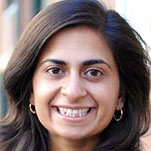Medical Journal Articles Authored by Women Are Cited Less Often Than Articles Authored by Men
Posted on Jul 07, 2021 | Comments 0

Dr. Chatterjee
A new study by Paula Chatterjee an assistant professor of general internal medicine and Rachel Werner, executive director of the Leonard Davis Institute for Health Economics at the University of Pennsylvania, finds that articles published by women in high-impact medical journals have fewer citations than those written by men, especially when women are primary and senior authors.
Researchers found that of the 5,554 articles published in five leading academic medical journals between 2015 and 2018, 35.6 percent had a female primary author, and 25.8 percent had a female senior author. During this period, the articles with women as primary author were referenced in other academic articles a median of 36 times, compared to 54 citations of articles with male primary authors. The trend extended to articles with female senior authors, which were cited a median of 37 times, while articles by male counterparts received a median of 51 citations. Original articles with women as both primary and senior authors were cited the fewest times, with a median of 33 citations, whereas articles authored by men as both primary and senior author were cited the most, a median of 59 times.

Dr. Werner
Authors also note that some of the journals included in the study focus on the field of internal medicine, which typically has a higher proportion of women represented than other clinical specialties. As a result, the findings may actually underestimate differences in scholarly article citations between male and female authors.
“The number of times a peer-reviewed articles cited by other researchers is commonly used as a metric for academic recognition, influence, as well as in professional evaluations and promotions,” says Dr. Chatterjee. “Female academics already face a number of barriers to career advancement, and the disparity in citations only broadens the gap between them and their male peers.”
“Gender disparities in citations are just one way in which inequities in academic medicine should be examined,” added Dr. Warner. “Our findings highlight that disparities stem in part from inequities in recognition and amplification of research. This imbalance will not be solved through hiring and mentoring more women alone. We must also work to ensure that women already in academic medicine are equally valued and promoted for their contributions and their successes. From the journals publishing this work, to academic institutions promoting articles once published, everyone should be invested in bridging this gender divide.”
The full study, “Gender Disparity in Citations in High-Impact Journal Articles,” was published on JAMA Open Network. It may be accessed here.
Filed Under: Gender Gap • Research/Study








